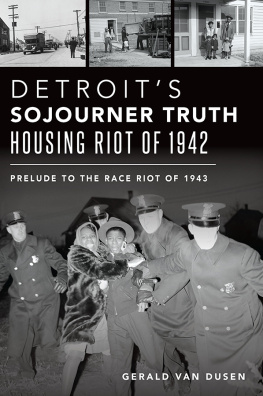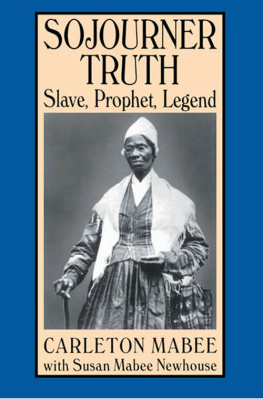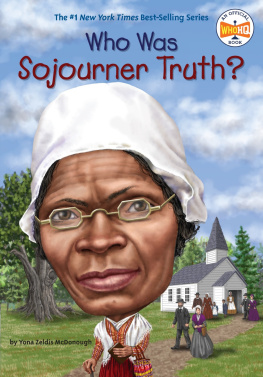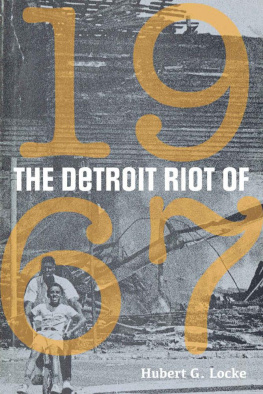Gerald Van Dusen - Detroit’s Sojourner Truth Housing Riot of 1942
Here you can read online Gerald Van Dusen - Detroit’s Sojourner Truth Housing Riot of 1942 full text of the book (entire story) in english for free. Download pdf and epub, get meaning, cover and reviews about this ebook. year: 2020, publisher: The History Press, genre: Politics. Description of the work, (preface) as well as reviews are available. Best literature library LitArk.com created for fans of good reading and offers a wide selection of genres:
Romance novel
Science fiction
Adventure
Detective
Science
History
Home and family
Prose
Art
Politics
Computer
Non-fiction
Religion
Business
Children
Humor
Choose a favorite category and find really read worthwhile books. Enjoy immersion in the world of imagination, feel the emotions of the characters or learn something new for yourself, make an fascinating discovery.
- Book:Detroit’s Sojourner Truth Housing Riot of 1942
- Author:
- Publisher:The History Press
- Genre:
- Year:2020
- Rating:4 / 5
- Favourites:Add to favourites
- Your mark:
- 80
- 1
- 2
- 3
- 4
- 5
Detroit’s Sojourner Truth Housing Riot of 1942: summary, description and annotation
We offer to read an annotation, description, summary or preface (depends on what the author of the book "Detroit’s Sojourner Truth Housing Riot of 1942" wrote himself). If you haven't found the necessary information about the book — write in the comments, we will try to find it.
Detroit’s Sojourner Truth Housing Riot of 1942 — read online for free the complete book (whole text) full work
Below is the text of the book, divided by pages. System saving the place of the last page read, allows you to conveniently read the book "Detroit’s Sojourner Truth Housing Riot of 1942" online for free, without having to search again every time where you left off. Put a bookmark, and you can go to the page where you finished reading at any time.
Font size:
Interval:
Bookmark:



Published by The History Press
Charleston, SC
www.historypress.com
Copyright 2020 by Gerald Van Dusen
All rights reserved
First published 2020
E-Book edition 2020
ISBN 978.1.4396.7088.0
Library of Congress Control Number: 2020938460
Print Edition 978.1.4671.4696.8
Notice: The information in this book is true and complete to the best of our knowledge. It is offered without guarantee on the part of the author or The History Press. The author and The History Press disclaim all liability in connection with the use of this book.
All rights reserved. No part of this book may be reproduced or transmitted in any form whatsoever without prior written permission from the publisher except in the case of brief quotations embodied in critical articles and reviews.
CONTENTS
FOREWORD
Professor Van Dusen is a friend and partner of the Fair Housing Center of Metropolitan Detroit in our mission to achieve equal housing opportunities for all. Detroits Sojourner Truth Housing Riot of 1942 graphically illustrates the importance of equal housing opportunities.
I have lived in the metropolitan Detroit area for over sixty years and lived in three homes in the city of Detroit and in homes in the immediate suburbs. I thought I knew about Detroits Birwood Wall, commonly known as the 8 Mile Wall. The wall was built in 1941 to racially separate a white neighborhood from a black neighborhood, illustrating metropolitan Detroits sad and tragic history of racial division and segregation. The fact that the wall was constructed to assist white residents in obtaining federally funded financing shows governmental complicity and involvement in racist housing practices.
That is, I thought I had a good understanding of the Birwood Walland the metropolitan Detroit areauntil I read Professor Van Dusens widely acclaimed book Detroits Birwood Wall: Hatred and Healing in the West Eight Mile Community. In Detroits Birwood Wall, Professor Van Dusen puts the Birwood Wall in its historical context. The wall was built after decades of segregation and oppression of black residents of Detroit, as well as an even larger population of black immigrants from the South, in terms of housing, education, public accommodations, transportation, healthcare and other areas of everyday life. Detroits Birwood Wall provided a clear, chronological picture of what had been scattered historical events.
After reading Detroits Birwood Wall, I was stunned by the decades of exclusion and subjugating segregation of black Detroit residents and large numbers of black immigrants. I could now look at Detroit and the surrounding suburbs and understand why the metropolitan Detroit area remains so highly segregated. I was also disappointed that no one ever had explained metropolitan Detroits racial background in a clear fashion.
Professor Van Dusen does the same thing in Detroits Sojourner Truth Housing Riot of 1942. He places the Sojourner Truth Housing Riot of 1942 in a clear, chronological context. Reading Detroits Sojourner Truth Housing Riot of 1942 is like watching events in a movie unfold. As Professor Van Dusen puts it: The trouble began, it can be said, with a single letter. Viewing the buildup of racial rhetoric and hostility leading up to the letter and the following chain of events resulting in the race riot, one is left to question how residents and community leaders, as well as local, state and federal government officials, will deal with racially charged events in the future.
I appreciate two aspects of Professor Van Dusens writing. First, it is apparent that Professor Van Dusen is not writing to convince his readers. Detroits Sojourner Truth Housing Riot of 1942, like Detroits Birwood Wall, is meticulously researched. He offers little commentary and allows the facts to speak for themselves. Detroits Sojourner Truth Housing Riot of 1942 shows the failure of leadership at all levels.
Second, Professor Van Dusen, as an English professor, is a gifted writer. Detroits Sojourner Truth Housing Riot of 1942, like Detroits Birwood Wall, is exceptionally well written. Those with busy schedules will appreciate Professor Van Dusens effective communication.
There are a couple of things I would like to see. I would like to see Detroits Sojourner Truth Housing Riot of 1942 used in high school and college courses. With the aid of a study guide with discussion questions, students should have the opportunity to read and discuss each chapter of the book. It is helpful to know history. It is far more valuable to learn from it.
The questions Professor Van Dusen raises in Detroits Sojourner Truth Housing Riot of 1942 naturally lead to discussions. Could one of the worst race riots in American history have been averted? What is it about the political realities of that era that made desegregation not a realistic option? Would more public housing have mitigated some of the racial tension? And how could the largely implacable attitudes and behaviors of white residents and immigrants in interacting with black residents and immigrants in major employment centers, on the streetcars and in the public parks and elsewhere have been addressed to achieve racial harmony? These were penetrating questions in that day. They remain penetrating questions in our day.
I WOULD ALSO LIKE to see Professor Van Dusen continue writing on these topics. Perhaps his next books will address the 1943 Detroit race riot, the 12th Street Riot of 1967, the Packard Hate Strike or other events. Professor Van Dusen mentions the 1943 race riot in chapter 2 and in his conclusion. There is little question that Professor Van Dusen would address the 1943 and 1967 riots as well as he has covered Detroits Sojourner Truth Housing Riot of 1942 in this book and the Birwood Wall in his previous book.
Finally, I would like to see Detroits Sojourner Truth Housing Riot of 1942 and Professor Van Dusens other books reach a nationwide audience. In chapter 5, Professor Van Dusen shows how the Sojourner Truth Housing Riot of 1942 became a national and international issue. The incidents also led to grand jury indictments, though the largely negligible results from the prosecutions would hardly deter subsequent racially motivated criminality. Professor Van Dusen makes sure we learn from this history.
Steve Tomkowiak
Executive Director
Fair Housing Center of Metropolitan Detroit
INTRODUCTION
On April 29, 1942, just five short months after the infamous attack on Pearl Harbor and President Franklin Delano Roosevelts impassioned request of Congress for a declaration of war against Japan, Detroiter Walter Jackson, a short, wiry, thirty-five-year-old former UAW-CIO shop steward, prepared for the battle of his life. We are here now, and let the bad luck happen, Jackson told an on-scene reporter. I have only got one time to die and Id just as soon die here.
Jackson was not talking about confronting the Germans on the battlefields of Europe or the Japanese on the islands of the South Pacific. The enemy he was about to confront was a large group of fellow Americanswhite Americanshellbent on preventing him, his family and other African American defense workers from moving into a defense housing project on the northeast side of Detroit.
Next pageFont size:
Interval:
Bookmark:
Similar books «Detroit’s Sojourner Truth Housing Riot of 1942»
Look at similar books to Detroit’s Sojourner Truth Housing Riot of 1942. We have selected literature similar in name and meaning in the hope of providing readers with more options to find new, interesting, not yet read works.
Discussion, reviews of the book Detroit’s Sojourner Truth Housing Riot of 1942 and just readers' own opinions. Leave your comments, write what you think about the work, its meaning or the main characters. Specify what exactly you liked and what you didn't like, and why you think so.






